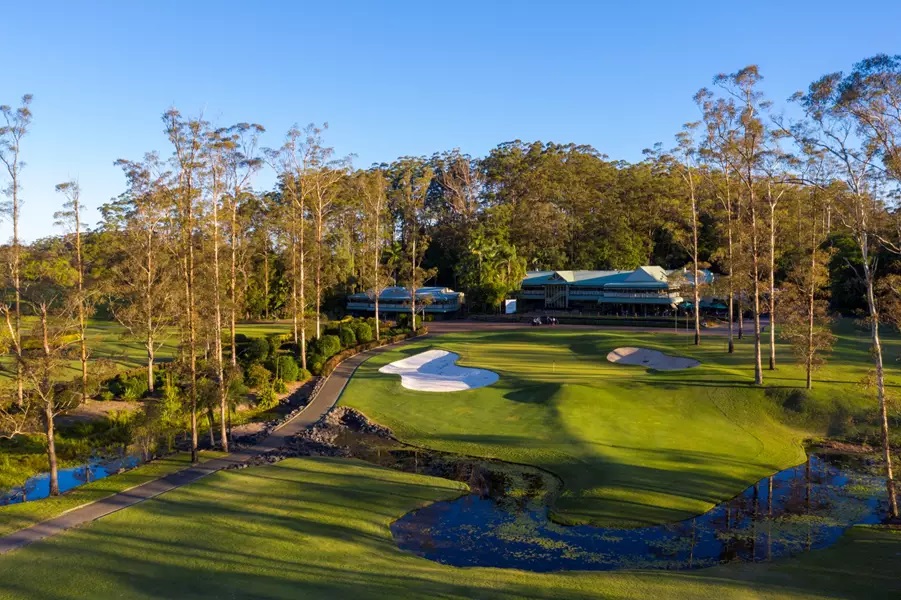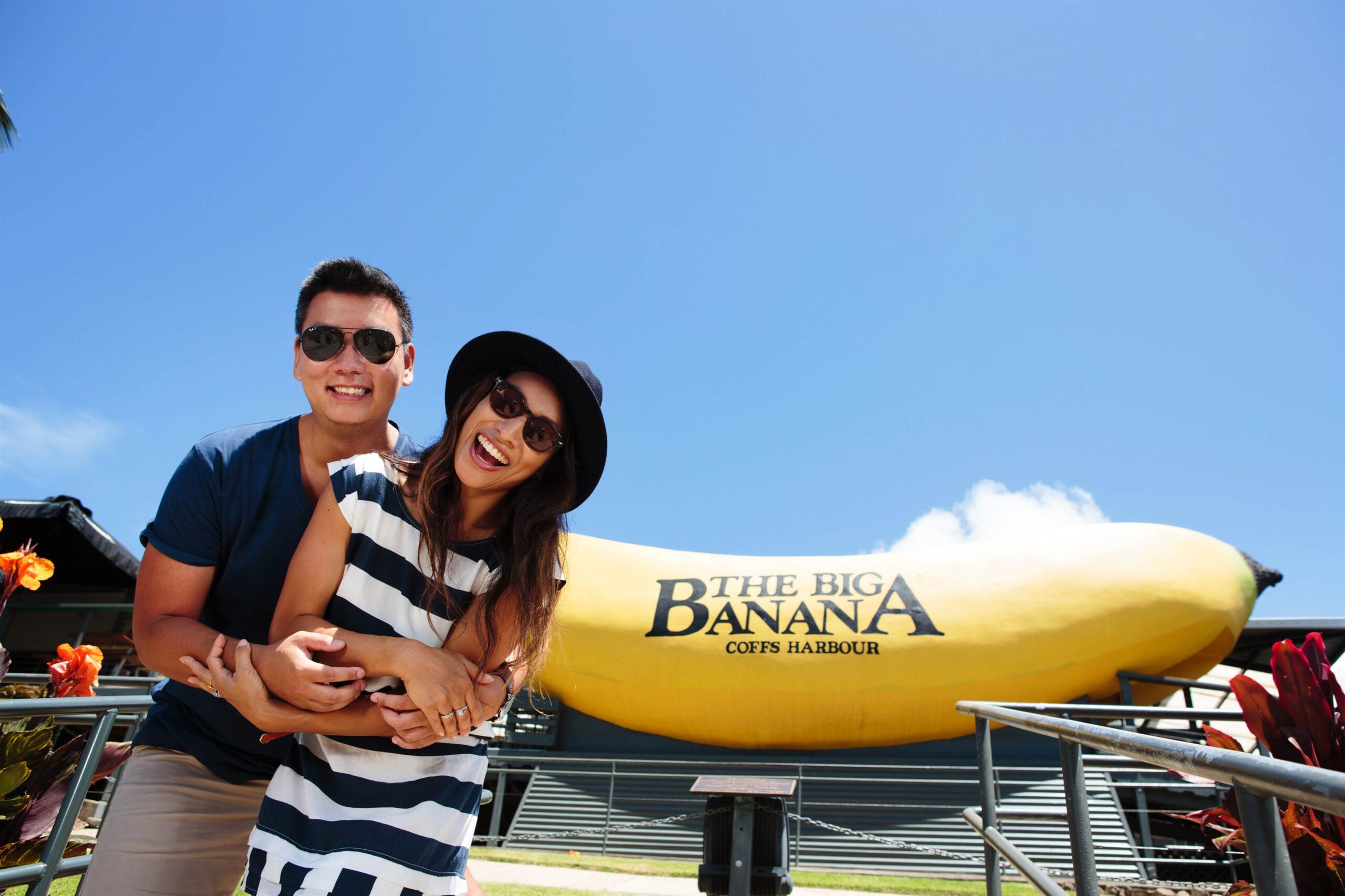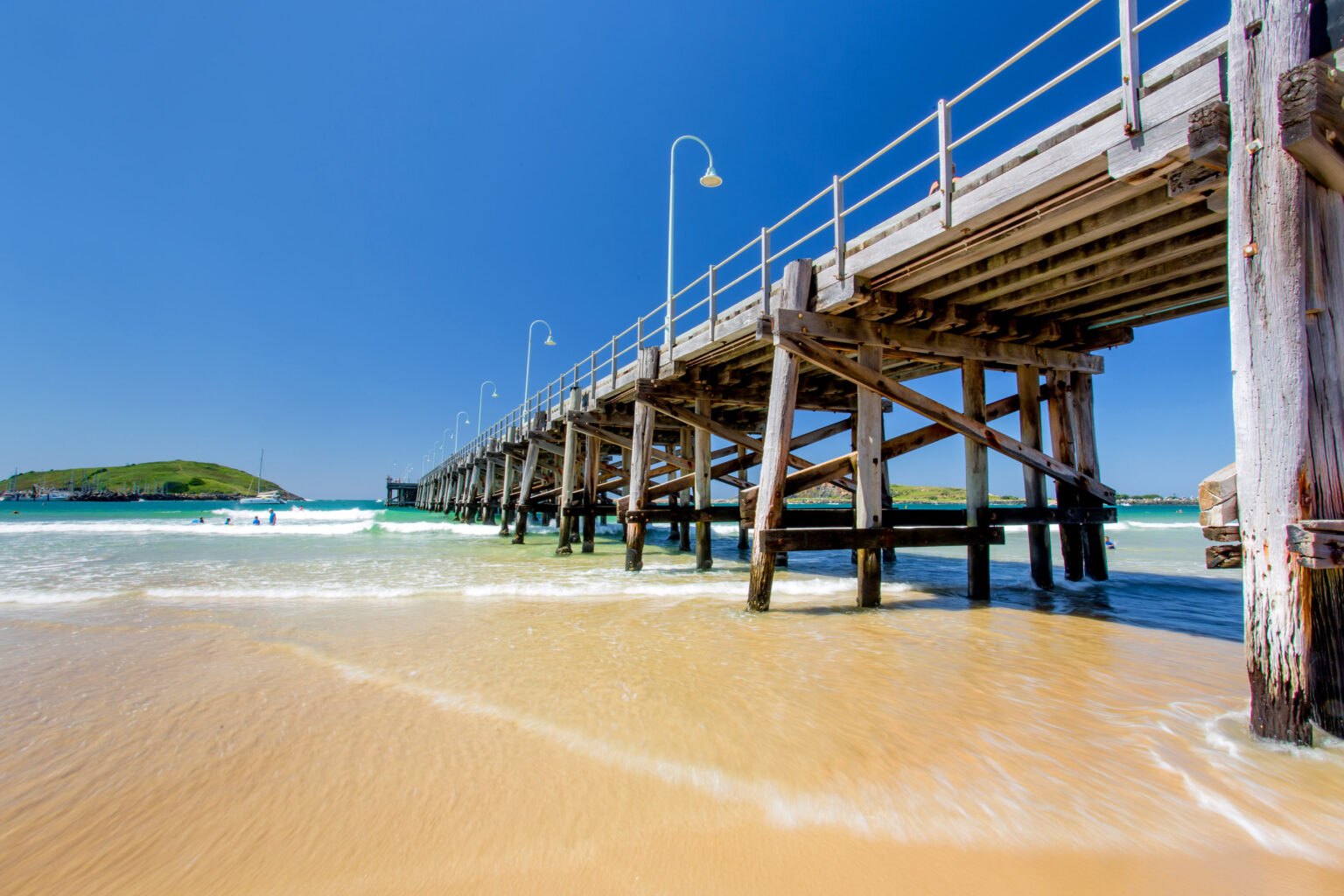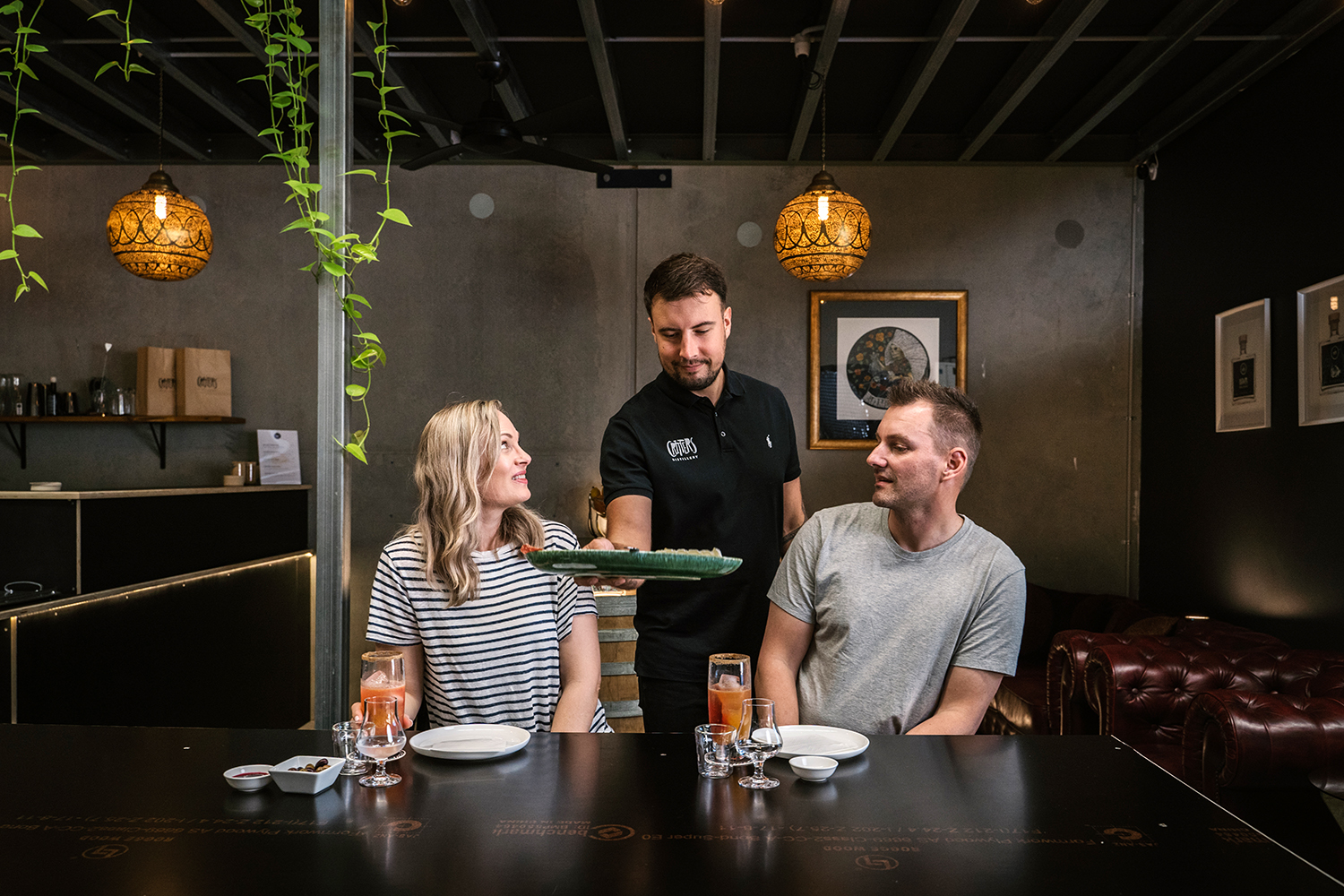There are just a handful of places along the length of Australia’s east coast where the majestic great dividing range comes close to meeting the edge of the Pacific Ocean.
The Coffs Coast, almost halfway between Sydney and Brisbane via the Pacific Highway, is one of those places. The sub-tropical climate here provides what has often been described as one of the most liveable environments in the country.
Surrounded by National Parks and looking out to the magnificent Solitary Islands Marine Park, Coffs Harbour – the region’s hub – is famously home to Australia’s first ‘Big Thing’ – the Big Banana. But there’s certainly plenty more to enjoy here.
There’s a wide range of exciting activities, including fishing, scuba diving, white-water rafting and dolphin spotting, complementing the abundant natural attractions and uncrowded beaches. There are also impressive resorts and hotels to choose from, while foodies will love the award-winning cafés and restaurants in abundance across the region.
And then, of course, there is a fine selection of golf courses to play.
Any golf holiday on the Coffs Coast must include at least one round at Bonville Golf Resort – a mainstay of Golf Australia magazine’s Top-100 Courses ranking for the past two decades and has been voted Australia’s Favourite Course by our readers every year since 2016. One round here, and you will agree the plaudits are well-deserved.
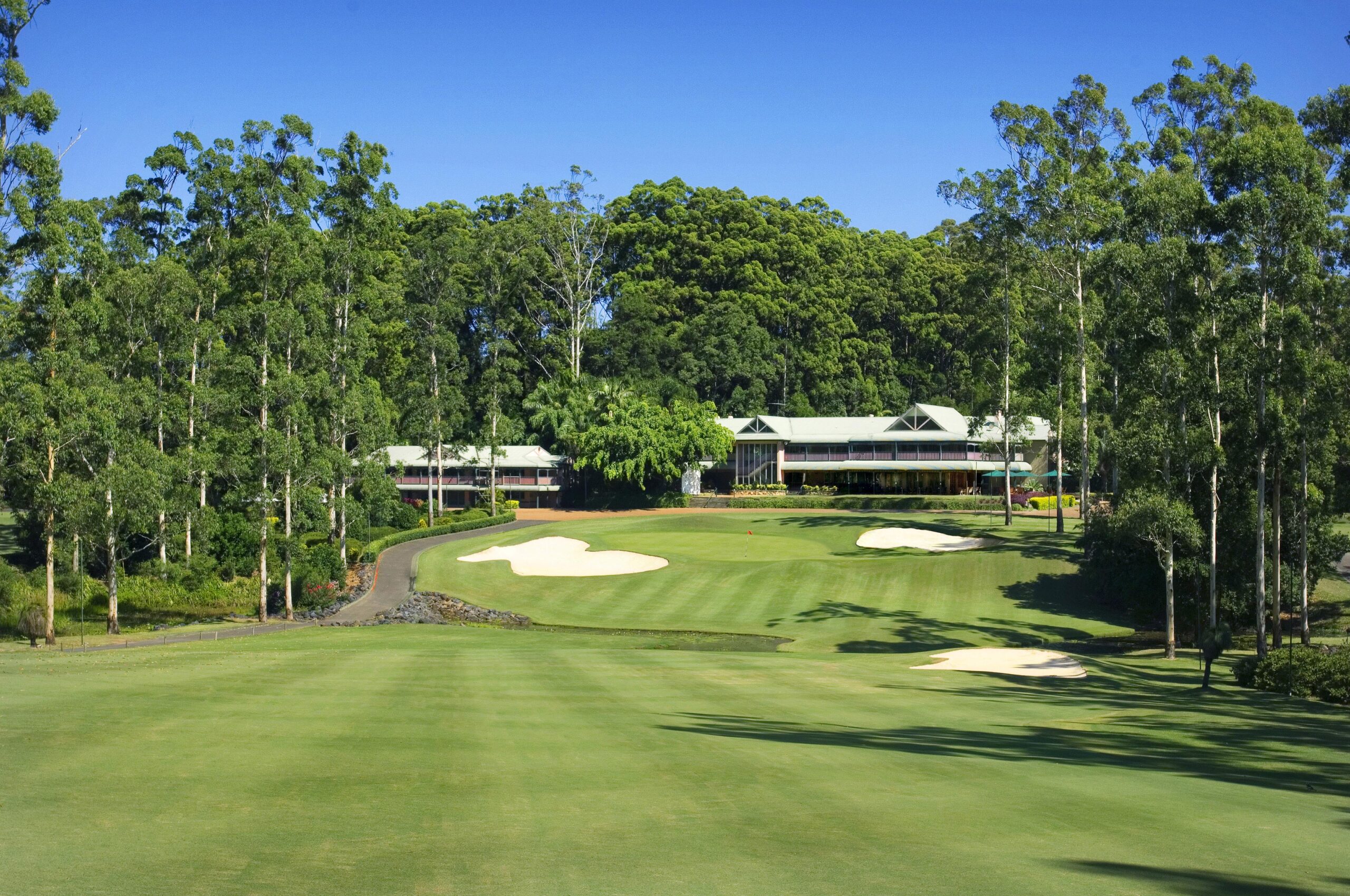
The greatest strides in Bonville’s evolution have occurred during the past decade with the playing surfaces and bunkering being consistently presented to a five-star standard.
One of the highlights of this Ted Stirling and Terry Watson-designed layout is its call to pull the driver from your bag and have a lash. There are few more spectacular sights than watching your drive from one of the many elevated tees sailing above and then between the strands of flooded gums lining the fairway. The 346-metre 2nd is one such hole where the fairway descends gradually from the tee and slopes markedly from right-to-left as it turns at 45 degrees right and climbs to the green. Trying to cut the corner with your tee shot is fraught with danger as flooded gums and bunkers come into play. Ideally, a faded drive down the centre of the fairway will leave you a mid- to short-iron approach to the green. Bunkers come into play around the green but it is the majesty of the flooded gums either side of the fairway and green that will take your breath away.
The same Bonville ‘magic’ will impress as you prepare to drive from the photogenic 18th hole. The 460-metre closer is not a long par-5 by modern standards, particularly when the second half of the hole is downhill. A well-struck tee shot here to the crest of a hill will leave you with a decision to make – do you go for the green or do you lay-up, and where? Before you load up, soak in the view. Strategy is all-important here, as a bunker and a stream cutting through the fairway short of the green come into play. Some longer hitters may only require a mid- to short-iron to the green after driving over the hill, but it remains a tough approach, which ideally needs to be left on the low side of the hole.
In March 2024 Bonville Golf Resort joined the Great Golf Courses of Australia (GGCA) as a member of the elite Signature Tier. A partnership between Tourism Australia, state tourism bodies and the golf industry, Great Golf Courses of Australia showcases the best of Australia’s golf product to international markets
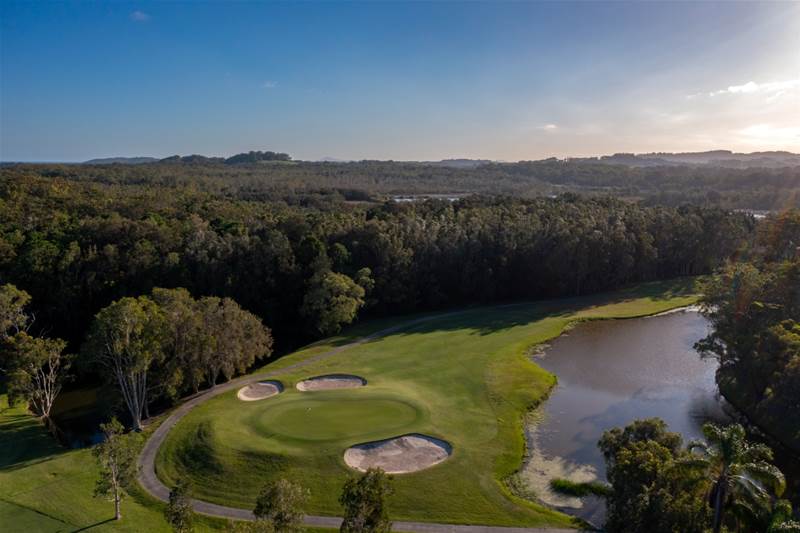
Long before the establishment of the Bonville Golf Resort in 1992, the Coffs Harbour Golf Club – just minutes from the centre of town – was gaining acclaim for its challenging layout. In fact, there was a long period of time during the 1950s and ‘60s when Australia’s best players and a few overseas stars were annual regulars for the North Coast Open.
The honour board for the event reads like a who’s who of golf in that era. Ten years before he won the centenary Open Championship, Kel Nagle was a victor at Coffs Harbour. He won three of the next four titles before handing over the winner’s baton to the great South African Gary Player, who won twice. A young Bruce Crampton followed with former Australian Open champ Frank Phillips, the legendary Norman Von Nida also picking up a winner’s cheque. Billy Dunk snared four titles between 1966 and 1971, a few years before the event became an amateur open event. The North Coast Open – the first tournament in Australia to be played as four rounds over four days – has been played at Coffs Harbour for more than six decades and during that time there have been plenty of major changes made to the original course.
The club moved to its present site in 1938 with Carnegie Clark designing the original nine-holes. Course designer Arthur East oversaw the extension of the layout to 18 holes less than 12 months before Nagle’s 1951 North Coast victory. A further nine holes were added in the early ‘70s, while all the putting surfaces were converted to Bermuda Tifgreen 328 grass in the late ‘80s.
“Subtle elevation changes and a wide variety of different holes requiring a range of shots, combined with beautifully manicured fairways and greens, make Coffs a favourite for me.”
Top-100 ranking judge Daniel O’Keefe.
More recently, former PGA Tour player and course designer Craig Parry has worked closely with course superintendent Justin Sheehan to implement some design changes on key holes ahead of creating a masterplan for further renovations.
Coffs Harbour not only boasts a wonderful history, it is one of the most challenging and best-maintained layouts in regional NSW, which didn’t go unnoticed by Golf Australia magazine ranking judges as the Lakes Course (Holes 1-18) rose four places to No.85 in 2023.
“Subtle elevation changes and a wide variety of different holes requiring a range of shots, combined with beautifully manicured fairways and greens, make Coffs a favourite for me,” ranking judge Daniel O’Keefe said.
The picturesque seaside town of Nambucca Heads is an easy 40-minute drive south of the Coffs Harbour course. This is where the Nambucca River flows into the sea and there are several lookouts dotted along the headlands offering spectacular views – to South West Rocks to the south, north towards Coffs Harbour and west along the river to the mountains. This westerly aspect also provides a glimpse of the town’s unique golf course.
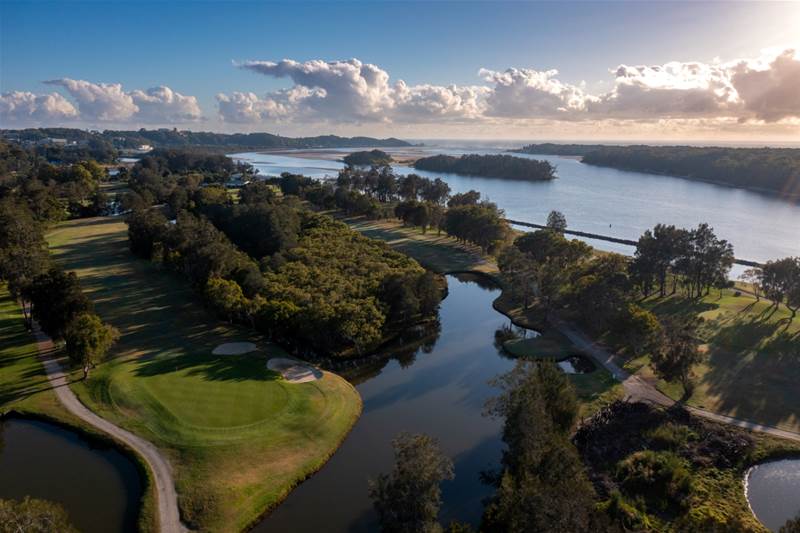
The par-69 layout of the Nambucca Heads Island Golf Club is the only course in Australia that occupies an entire island. The original nine-hole course was extended to an 18-hole layout in 1992 to occupy all of Stuart Island in the Nambucca River, just upstream from where the river meets the sea.
It is a picturesque layout that – like several lesser-known courses in the Coffs Coast region – will surprise the visiting golfer expecting “just another country course”. Nambucca Island is certainly more than that.
Whether it is the waters of the Nambucca River, rows of pine trees or casuarinas, bunkers or the rise and fall of the greens, each hole has at least one defence or a combination of the above. The 354-metre par-4 1st throws down the challenge from the opening tee shot. Although the fairway is generously wide, the beautiful Nambucca River laps at the shore just a few metres from the left edge of the fairway.
In March last year it was a much different scene with the river breaking its banks and covering most of the course in floodwater and accompanying silt. It was a similar story to varying degrees for courses right across the Coffs Coast region, but all have since recovered nicely.
Standing in the middle of the short par-4 3rd hole, the couch fairway is pure and carpet-like. Up ahead, the putting surface is smooth beneath the morning dew. It’s hard to imagine this hole was one of many that were six feet under water at the height of the floods. The recovery has been amazing.
There are several water hazards – apart from the river – that come into play throughout the round, which features some standout short holes.
The slight dogleg left par-4 6th measures 326 metres from the tips and can be played a variety of ways, as long as you avoid the wetlands that line the left edge of the fairway. The hazard also wraps around the back of the green, adding some spice to the shot and club selection for the second shot.
Water also plays a role on the next hole, arguably Nambucca’s best par-3. The 175-metre 7th features a large, beautifully shaped green that is the target beyond a lake and a stream, which cuts in front of the green and winds along the right of the small section of fairway short of the putting surface.
Playing the ‘Island’ at Nambucca is more than just memorable for the river and its tree-lined fairways. It is a fun course to play.
Halfway between Nambucca Heads and Coffs Harbour, and about 10 minutes’ drive west of the Pacific Highway via Waterfall Way, is the beautiful hinterland town of Bellingen – renowned for its cultural festivals, markets and an appetite-satisfying destination for food lovers.
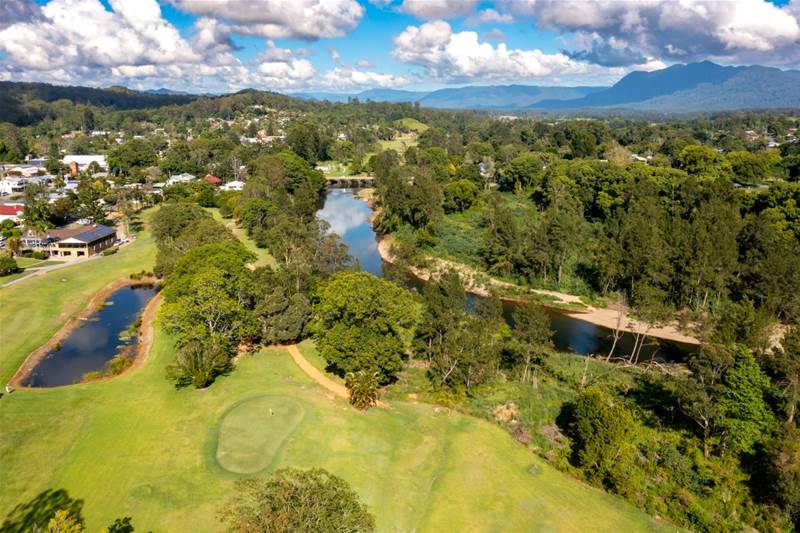
It is also home to the scenic Bellingen Golf Club. Framed by the Great Dividing Range and lying beside the snaking Bellinger River, the beautifully tree-lined Bellingen layout features ten greens and alternate tees for 18 holes laid out across interesting terrain.
Two ridges run through the length of the Bellingen course creating some unique holes among huge camphor laurels and ancient fig trees. The best of these is the 456-metre par-5 4th hole, which is a tight driving hole that tracks the valley between the two ridges, and massive trees, before doglegging slightly right to leave an uphill approach to a tiny green perched above the fairway.
It’s a similar story playing the next – a terrific short par-4 of 308 metres where you play alongside a ridge to an expansive fairway before the hole turns slightly left and climbs the ridge to a wide elevated green. On the back nine, the approach is very different when played as the 265-metre 14th as the tee is located behind the 13th green (a green you only play once during the 18 holes) leaving a subtle dogleg right that favours the right-handed faders among us.
Heading north from Bellingen, take another diversion from the Pacific Highway to reach one of the prettiest villages on the NSW north coast, Sawtell. This idyllic beachside location is a good fit with the easy-going vibe here.
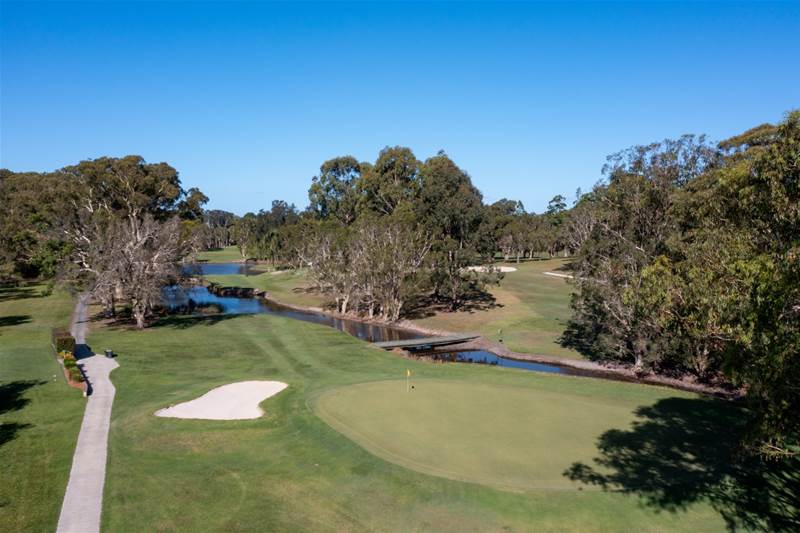
Sawtell’s main street, just a short stroll from the beach, has some great cafés and restaurants. If you’re looking for a good coffee and a nice view, you’ll get both, as you wile away the time before another round of golf, at the Sawtell Surf Club’s The Kiosk. The views across the beach to the breaking waves are outstanding and the coffee is pretty good too.
Sawtell Golf Club is only a bit more than a lengthy par-5 from the beach via the town’s pretty Moreton Bay fig-lined main street.
The course first opened for play in 1946 and over the years more holes were added to finally complete a par-71 18-hole course. The layout was completely redeveloped during the 1990s, as the club’s greens staff worked through a systematic rebuilding of all the putting surfaces. The old table-top greens were replaced with larger, more imaginative, putting surfaces featuring swales and tiers. They were grassed with Bermuda Tifgreen 328, which is more suitable for greens in warmer and wetter sub-tropical climates. The modernising of the greens also gave scope for improving greenside bunkering.
Today, Sawtell’s green complexes are among the best presented on the NSW North Coast.
After playing the downhill 1st hole, the par-4 2nd climbs the same hill back to the clubhouse. It plays considerably longer than its 279 metres and accuracy is needed to avoid the tall gum trees that cloak the tee and form a chute to the fairway. Club selection for the approach shot is important and can be two- to three-clubs more than what you may need for a flat lie shot. The green slopes steeply off the front, while the top plateau has a dish-like appearance, while the huge bunker left of the green is best avoided.
Chances are if you are travelling to the Coffs Coast for the first time you may not have heard of Safety Beach Golf Club.
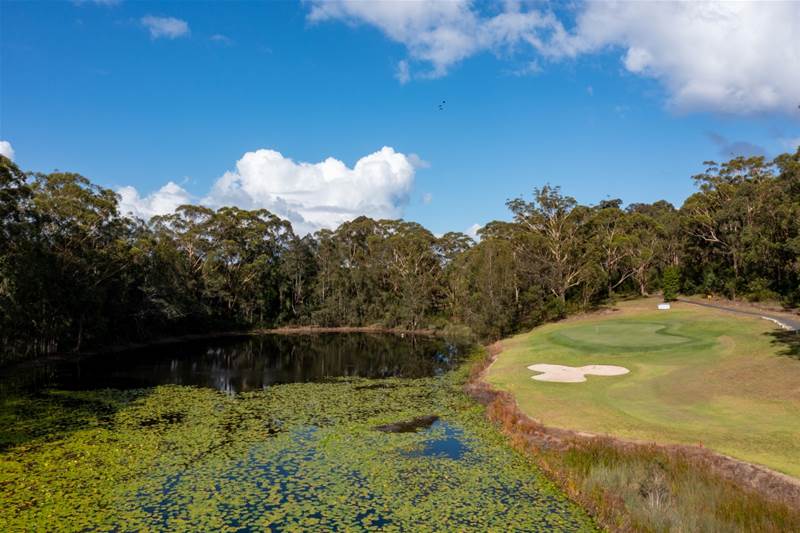
Previously known as the Woolgoolga Diggers Golf Club, Safety Beach covers some pretty good golfing terrain on the northside of Woolgoolga, about 30 minutes’ drive north of Coffs Harbour.
A round on the heavily tree-lined par-72 layout is nearly always played with an accompanying breeze. But the wind and huge trees across the course are not the only factors influencing your scoring here with numerous water hazards, wetlands and bunkers coming into play across the 18 holes.
The course opens with two short par-4s that can yield back-to-back birdies as easy as consecutive bogeys depending on the quality of your tee shot. But it’s not until you have rounded the sharp dogleg left on the par-5 3rd hole that you get a real sense of the course that lies ahead. Faced with a long downhill approach, the green is quite reachable in two blows but it is actually better to finish short as a pond lies just beyond the putting surface.
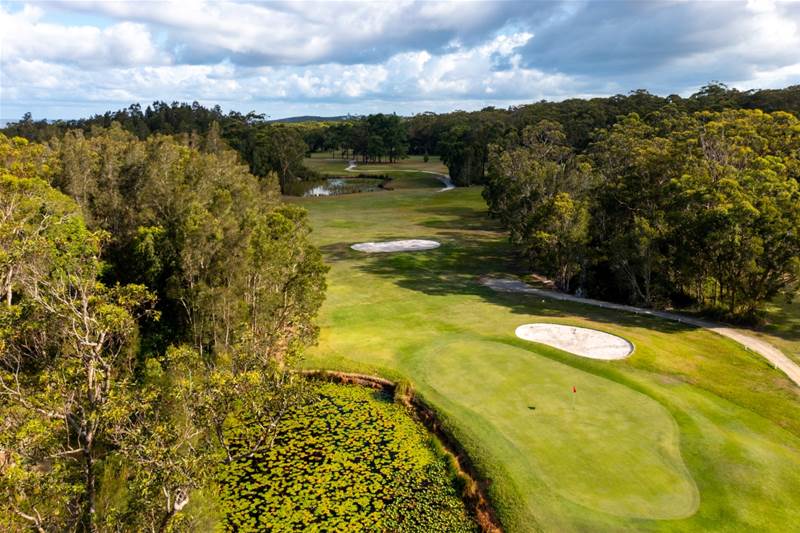
Water also comes into play greenside on the best, in my opinion, short par-4 at Safety Beach. The 283-metre 5th is tempting for big hitters standing on the tee, but I think I would back the conservative play to yield a birdie here. A water hazard stretches from the front of the tee all the way down the right edge of the fairway to flow into a lily-covered pond lying hard against the right fringe of the putting surface. Bets to lay-up short of a lone bunker in the middle of the fairway, about 40 metres short of the green, and leave a straightforward pitch into the narrow green.
There is more water to contend with on the back nine, with the tee shot on the 117-metre 11th hole being the most visually confronting. The tee shot needs to be played across a lake to an elevated green two-tiered, kidney-shaped green cut into the side of a hill. While the carry is not too daunting, it is the prospect that any shot missing the putting surface left could easily trickle down the hill into the drink.
For more golfing stories, check out. golfaustralia.com.au
This article was originally published in Golf Australia Magazine in February 2023. All images and editorial by Brendan James.
TOURING THE COFFS COAST
With a winning combination of excellent accommodation, a bustling foodie scene and jaw-dropping natural beauty, it’s no wonder the Coffs Coast has long been a popular holiday destination.
The Coffs Coast is the only place in NSW where the Great Diving Range meets the ocean… home to a rich ecosystem including world-heritage National Parks, State Forests, Flora Reserves and the Solitary Islands Marine Park, the oldest of its kind in the state. The region also boasts sites of great significance to the traditional owners of this land, the Gumbaynggirr People.
In 2021 the Coffs Coast was globally recognised as an ECO Destination … celebrated for its diverse cultural community, committed to balancing sustainable practices with first-class, nature-based visitor experiences. It is NSW’s first ECO destination.
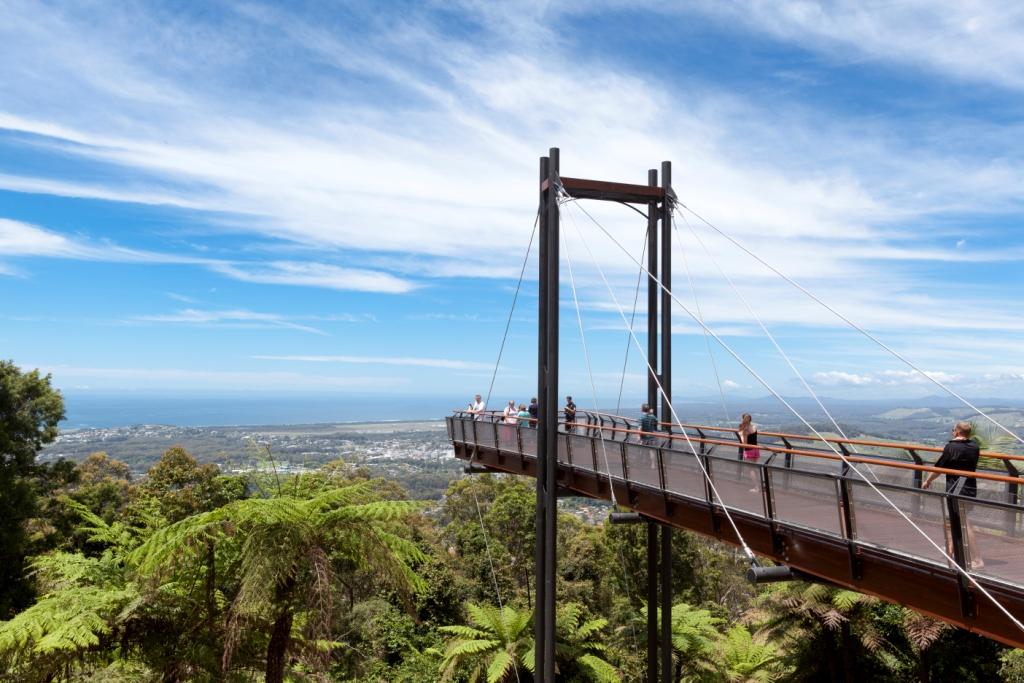
NATURE ESCAPES
Love the outdoors? Here are some great ideas for experiencing the natural wonders in and around Coffs Harbour.
• Stroll along the northern breakwall to Muttonbird Island, keeping an eye on the water to spot turtles and dolphins along the way. Then, take the steep walk over the island to the eastern lookout for unique views back over Coffs Harbour before visiting the island’s fascinating Gumbaynggirr outdoor learning centre.
• The Coffs Botanic Garden in the heart of the city is perfect for a picnic and relaxing walk. Set among 20 acres of lush plant life, you’ll find exotic and native species and glasshouses containing rare displays of tropical plants.
• No Coffs Coast holiday is complete without a visit to Forest Sky Pier and the award-winning Sealy Lookout, which stretches out from an escarpment 310 metres above Coffs Harbour and offers unparalleled coastal views of up to 100km to the south on a clear day.
• One of Coffs Harbour’s icons, The Jetty was built in 1890 from local timber to accommodate cargo vessels. Now it’s where locals congregate to fish, swim, stroll, watch the sunrise or dine on fish ‘n’ chips.
• Just five minutes from the city, Coffs Creek is an oasis for families who can safely paddle in its shallow turquoise waters. The creek and its mangrove forests can be easily accessed at several points, and are begging to be explored on a paddleboard or kayak.
FABULOUS FOOD & DRINK
The Coffs Coast packs a punch when it comes to foodie experiences. Whether it’s freshly caught seafood, fine wines, distilled spirits, craft beers or incredible coffee, there’s a foodie experience here to tickle your taste buds.
Immerse yourself in a full-day tour with the experts and learn about the stories behind our producers and the inspiration behind the flavours they create. Explore on your own and take your time relaxing with friends to discover the fabulous country hospitality while your taste buds experience the new and fresh unique regional flavours.
WHERE TO PLAY
BONVILLE GOLF RESORT
Green fees: Golf is available for in-house guests seven days and to general public guests on Mondays and Tuesdays (except public holidays). Public: $175 (18 holes, inc. cart, September to May); $170 (June to August).
COFFS HARBOUR GC
Green fee: $50 (18 holes).
www.coffsharbourgolfclub.com.au
BELLINGEN GC
Green fees: $20 (18 holes). $15 (unlimited golf after 2pm and all day Sunday).
SAWTELL GC
Green fee: $40 (18 holes).
NAMBUCCA HEADS ISLAND GC
Green fee: $40 (18 holes, pictured below)
SAFETY BEACH GC
Green fee: $19 (unlimited golf).
SOUTH WEST ROCKS CC
Green fee: $30 (18 holes).
